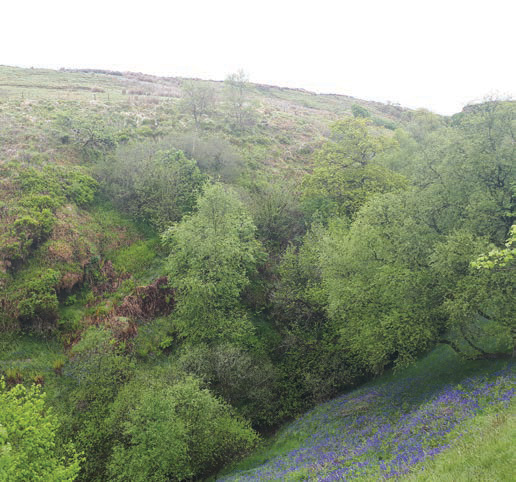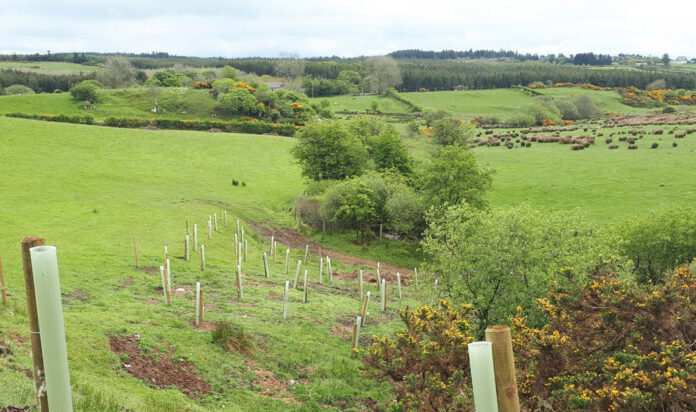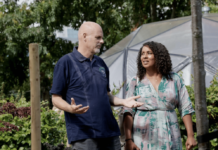After a visit to the Inishowen peninsula, Féidhlim Harty is hopeful for the integration of sustainable farming practices and the protection of watercourses
Last month, I visited the beautiful Inishowen peninsula to walk some farms. I was there at the invitation of the Inishowen Rivers Trust, a young and dynamic organisation, tasked with exploring opportunities to protect and improve the water quality of the rivers and
streams in the area. This northerly peninsula is a broad spread of hilly ground sandwiched between Lough Foyle and Lough Swilly. Small rivers and streams flow from the centre to
the sea on all sides, with the usual pressures of effluent from septic tanks and farming affecting the quality of the water. I won’t even begin to reflect on the potential impacts on water quality if gold mining in the peninsula is permitted.
On the day of the visit our task was down to earth, to walk those farms that had watercourses on the land and talk with the farmers and farm walk participants. We
explored ways to improve water quality and habitat value using a variety of measures, many of which had been implemented already in recent works. One farmer was just beginning to explore the potential options on her farm, whereas two others had already excavated new ponds to act as silt traps and accommodate wildlife. On one of the farms extra in-channel silt traps and generous belts of upland tree-planting had already been introduced. There were also areas of steep land that had been fenced off to protect vulnerable sloping woodland from erosion by overgrazing.
As a guest to the area, I was excited and encouraged to see the work being done here, both by the Rivers Trust itself and the Inishowen Uplands EIP (European Innovation Partnership), which facilitated the recent pond and tree planting works. All across
the country similar solutions are urgently needed. Small streams and farm drains are the headwaters of our river systems. The degree of pollution in these small headwaters sets the level of pollution in our nation’s watercourses which suffer ill health and have poor quality as a result.
The corollary is also true. If we can keep all the small drains and streams clean, clear and vibrant, our river water quality will have a chance to recover and revitalise. That’s no small task. If your kitchen tap, toilet or milking parlour wash-water eventually ends up being the spring that feeds your local headwater, then treating the grey water, sewage or farm run-off is crucial if we want pristine rivers and groundwater. But it’s doable. It’s readily achievable. Just as our collective lack of focus on this area up to now has led to a steady
reduction in water quality, so too a collective focus can reverse this trend.
So, if I had a wish-list of measures to roll out around the country, what would it include? Well, all of the measures I saw on my visit to these farms in Inishowen: Farm-scale buffer zones along drain and stream edges; silt traps and settlement ponds; in-channel wetland planting with check-dams to slow the flow and create mini pools in each drain section; upland tree-planting and strategic fencing for protection of vulnerable ground from livestock.
Also, as is being done in Donegal, changes to main farm practices. On one farm, the intention is to graze a herd of Galloway cows in upland areas to provide a different grazing
pattern to lands traditionally grazed by sheep. This measure is designed to shift the vegetation type away from purple moor grass, preventing it from becoming a monoculture, as is typical with sheep overgrazing. Closer to my own home in Co. Clare, the Burren Programme uses similar measures in the management of grazing patterns, ultimately helping to create a sward of spectacular Burren wildflowers. In general terms, what is good for wildflowers, wildlife and soil is good for water quality. Permanent pasture holds soil in situ and prevents silt spreading into nearby streams. It’s not rocket science, but it’s all important work that needs to be done. The more diverse the pasture the better. Multispecies swards are used on a third Inishowen farm, providing variability in root
depths, in turn providing a greater spread of micronutrients for livestock and greater drought resilience due to the use of deeper rooting species within the mix. Variable root depths also ensure that nutrients from dung and urine are captured at multiple levels within the soil, compared with shallow rooted ryegrass, which will absorb a more limited amount of the valuable Nitrogen and Phosphorous that may otherwise slip through unused, and become groundwater pollutants adding to waterway eutrophication.

Other measures are also available for protection of our waterways. New forestry grants for silvopasture are now encouraging tree planting within grazing lands. Agroforestry offers other ways to diversify farm incomes and use trees in the productive landscape, with all the associated benefits of carbon sequestration, water quality, flood control and wildlife
habitat provision. Land management techniques and farm practices such as farm-scale permaculture, farm composting and holistic planned grazing offer multiple benefits for food,
farmers and future.
I can’t pretend to have a fraction of the knowledge that any farmer has of their land and farm, but I know that if our farm payments policies push farmers in the direction of ever-increasing intensification without due regard for wildlife, water or soil health, then our farms, rivers and inhabitants – human and non-human alike – will be the poorer for it.
The EIP programmes, conservation agriculture groups and Rivers Trusts across the country have a growing role in striking a balance between the need for productive land and
the needs of nature; the balance between food production and other values the land provides such as flood protection, water filtration, pollination and space for nature. On so many levels the measures that we need to roll out will have benefits for everyone. For example, contour hedgerows protect farm animals from biting weather, provide habitats for pollinators, catch rainfall run-off from fields, filter out silt, recharge groundwater reserves, mop up nutrients and protect rivers and streams further down-hill. The benefits are manifold.
This isn’t complicated. Jump in. Get muddy. Try it out. Learn from mistakes and move forward. As I write, the next round of CAP is stalling in the apparent conflict between
productivity and nature. Who are we fooling? What is farm productivity but the evolution of our relationship with nature. We need to seek out the balance between productive space and protected space. We will never have enough human knowledge to ignore the process of evolution and the experimentation active in wild nature. Yet we can learn from nature and enjoy the many gifts that nature gives; crops and livestock for fuels, fodder, food and fibres. But we still need wild space, untamed, protected space, on our farms and off
them, where nature can do its thing, unseen, unregulated and uncontrolled.
It’s the edges that I love on farm walks. The wildflowers that push up through the grasses around newly fenced stream edges, the scrubby corners yearning to be ancient forests, the watercress pushing into the exposed sediments where a drain enters a newly dug pond. These are the meeting of worlds, where the busy farm life meets the space for the bumblebee, and crucially where water gets time to settle, to rest, to drop silt and release nutrients to the plants that emerge.
As I walk the works of Rivers Trusts and EIP projects I have hope for the future. Policy will catch up. Previous policy positions served post-war Europe at a time when we were hungry. Now policy needs to serve a new balance that honours the origins of agriculture itself, the foundation of wild nature in which farming ultimately has its roots. I believe it will not only give us better soil, cleaner water and fewer floods, it will also give us abundant healthy and
delicious food. ✽
  FÉIDHLIM HARTY is the director |








